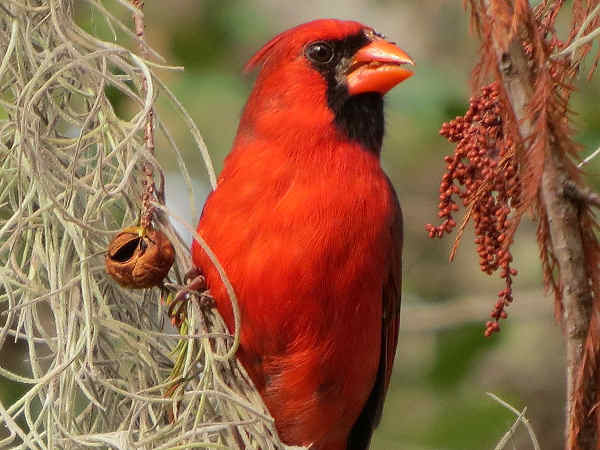Identifying red birds in Illinois is an exciting endeavor, but can you tell the difference between a Finch and a Tanager?
In Illinois, you can find a total of 11 species of red birds, each with its own unique characteristics. Out of these, 6 species are regularly observed according to state checklists, while 4 are considered rare or accidental visitors. Additionally, there is one introduced species in the mix.
This guide aims to assist you in identifying the diverse red bird species found in Illinois, drawing information from avibase. While some of these birds migrate, others remain in the region all year round.
To gain a comprehensive understanding of the bird species that grace your backyard, you can obtain a free bird identification worksheet specially designed for Illinois.
The Northern Cardinal takes the crown as the most frequently sighted red bird in Illinois, making appearances both in summer and winter. During the summer months, the Scarlet Tanager becomes more prevalent, adding to the vibrant avian population. Additionally, there are several species that exclusively grace us with their presence during the winter season. Read on to uncover more intriguing details about these captivating birds.
11 Red Birds in Illinois
1. Northern Cardinal

The Northern Cardinal is a widespread and frequently spotted red bird in Illinois, making appearances throughout the year.
Male Northern Cardinals showcase a vibrant red plumage that covers their heads, bodies, and tails, accented by contrasting black features around their faces. The females, equally captivating, flaunt brown feathers with a distinct brown crest, accompanied by red accents and red beaks.
Size: Ranging from 8.3 to 9.1 inches (21-23 cm) in length Weight: Weighing approximately 1.5 to 1.7 ounces (42-48 g) Wingspan: Spanning from 9.8 to 12.2 inches (25-31 cm)
Northern Cardinals primarily inhabit eastern and southern states, showcasing their presence during the breeding season by engaging in territorial disputes and occasionally attacking their own reflections.
To attract more Northern Cardinals to your backyard, you can entice them with offerings of sunflower seeds, peanut hearts, millet, or milo. They readily feed from large tube feeders, hoppers, platform feeders, or by simply scattering food on the ground.
2. House Finch
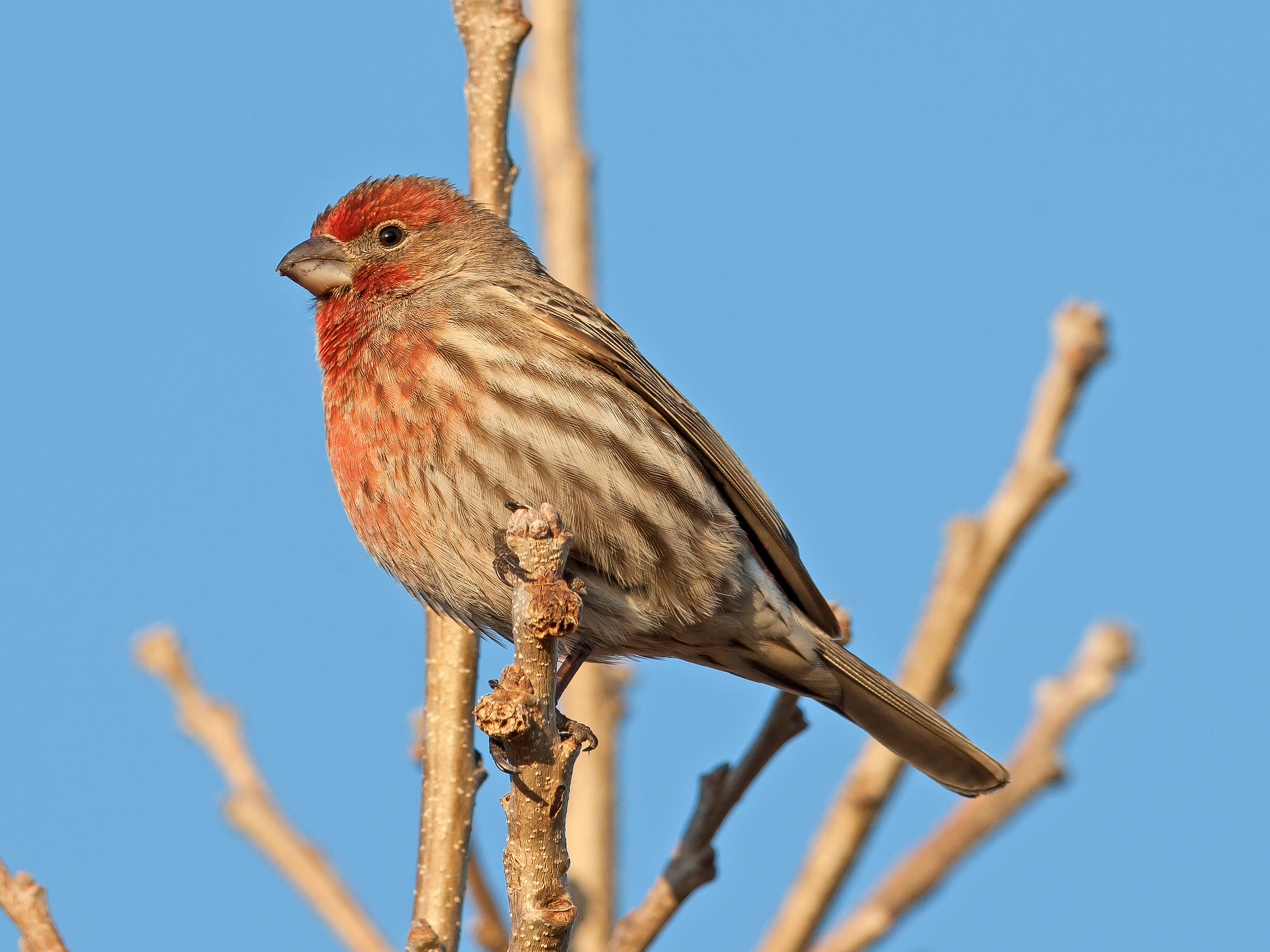
The House Finch, an introduced species in Illinois, can be spotted throughout the year.
Male House Finches display captivating red heads and breasts, while females flaunt plumage streaked with shades of brown.
Size: Ranging from 5.1 to 5.5 inches (13-14 cm) in length Weight: Weighing approximately 0.6 to 0.9 ounces (16-27 g) Wingspan: Spanning from 7.9 to 9.8 inches (20-25 cm)
Originally limited to western states, House Finches have successfully established themselves in the eastern regions, even outcompeting the native Purple Finch.
You can encounter House Finches in various habitats, including parks, farms, forest edges, and backyard feeders, often gathering in bustling groups that create a lively atmosphere.
To attract more House Finches to your backyard, offering black oil sunflower seeds or nyjer seeds through tube feeders or platform feeders can prove irresistible to these delightful birds.
3. Scarlet Tanager
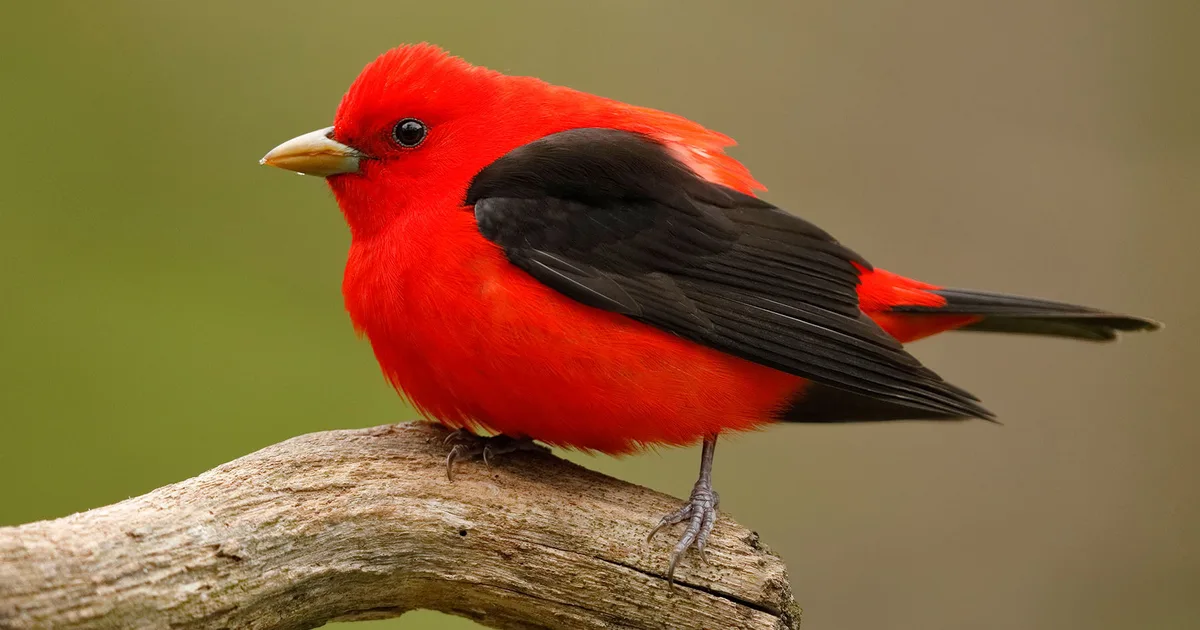
During the summer season, Illinois is graced with the vibrant presence of the Scarlet Tanager.
Scarlet Tanagers are stunning red birds adorned with striking black wings and tails. The females, equally captivating, showcase yellow plumage with darker wings and tails.
Scientific name: Piranga olivacea Size: Ranging from 6.3 to 6.7 inches (16-17 cm) in length Weight: Weighing approximately 0.8 to 1.3 ounces (23-38 g) Wingspan: Spanning from 9.8 to 11.4 inches (25-29 cm)
These magnificent birds breed in eastern forests during the summer before embarking on their migration journey to South America.
Scarlet Tanagers are often found high in the forest canopy, making them a delightful challenge to spot.
To attract more Scarlet Tanagers to your surroundings, consider planting an array of berry plants such as blackberries, raspberries, huckleberries, juneberries, serviceberries, mulberries, strawberries, and chokeberries. These fruit-bearing plants serve as a tempting feast for these beautiful birds.
4. Purple Finch

While not particularly common in Illinois, the Purple Finch occasionally makes an appearance throughout the year, especially during winter.
Purple Finches bear a resemblance to House Finches, sporting reddish-purple heads and breasts, but they possess more pronounced brown tones on their backs and wings.
Size: Ranging from 4.7 to 6.3 inches (12-16 cm) in length Weight: Weighing approximately 0.6 to 1.1 ounces (18-32 g) Wingspan: Spanning from 8.7 to 10.2 inches (22-26 cm)
These finches primarily breed in Canada and undertake a migration to eastern states for the winter. However, some individuals can be found year-round in the northeastern region and along the Pacific coast.
You are likely to encounter them in evergreen forests, where they forage for a diet consisting of seeds, buds, nectar, and berries.
If you wish to attract Purple Finches to your vicinity, offering them black oil sunflower seeds through feeders will undoubtedly entice their presence.
5. Summer Tanager
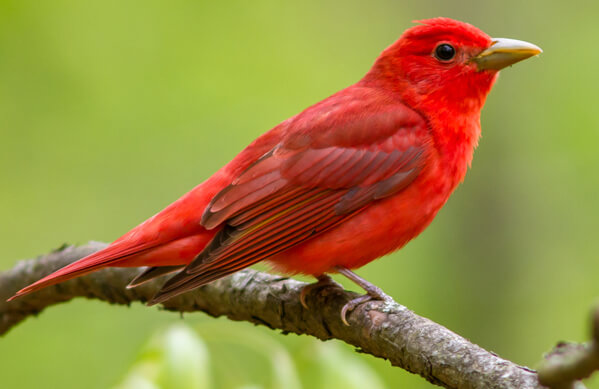
From April to October, Illinois is graced by the presence of the Summer Tanager, with its stunning red plumage.
Male Summer Tanagers exhibit a vibrant shade of red, while females display a striking yellow coloration.
Scientific name: Piranga rubra Size: Approximately 6.7 inches (17 cm) in length Weight: Around 1.1 ounces (30 g)
Before embarking on their winter migration to Central and South America, these birds breed in southern and eastern states.
You can find Summer Tanagers in open woodlands, where they make their homes. Their diet primarily consists of bees and wasps, which they skillfully catch mid-flight. To enjoy their meal, they beat their prey against a branch to remove the stinger before consuming them.
To attract these vibrant birds to your backyard, consider incorporating berry bushes and fruit trees into your landscape.
6. Common Redpoll
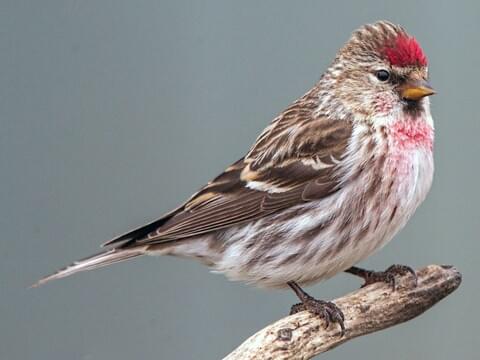
In the winter months, the northern regions of Illinois become a temporary home for the Common Redpoll.
These charming birds boast red foreheads, pinkish breasts, and a combination of brown and white plumage on the rest of their bodies.
Scientific name: Acanthis flammea Size: Approximately 4.7-5.5 inches (12-14 cm) in length Weight: Ranging from 0.4-0.7 ounces (11-20 g) Wingspan: Typically 7.5-8.7 inches (19-22 cm)
Common Redpolls primarily inhabit the northern states during winter, with occasional sightings in central states.
When faced with chilly nights, these resourceful birds may burrow into the snow to keep warm. Their appetite is impressive, as they can devour up to 42% of their body mass in seeds daily. To accommodate their hearty appetite, Common Redpolls have a stretchy esophagus capable of storing up to 2 grams of seeds.
You can spot them in weedy fields or feeding on catkins in trees. If you provide feeders with small seeds like nyjer seeds or thistle, they will readily visit and delight in the offerings.
7. Red Crossbill

In Illinois, spotting a Red Crossbill can be a bit of a challenge, but there have been occasional sightings near Chicago.
Male Red Crossbills sport a brilliant red plumage, complemented by darker wings and tails, while females showcase a lovely blend of yellow and brown feathers.
These unique birds can be found throughout the year in northern and western states. During the winter, they make their way to eastern states for sightings.
Red Crossbills have a special affinity for conifer seeds and are skilled at navigating from tree to tree in search of their favorite food. Their distinctive beaks, designed for precision and power, allow them to pry open unopened cones to access the delicious seeds within. In the mornings, you may even catch them consuming grit along roadsides.
Keep a keen eye and ear out for these remarkable birds, as their presence adds a touch of wonder to the natural landscape of Illinois.
8. White-winged Crossbill
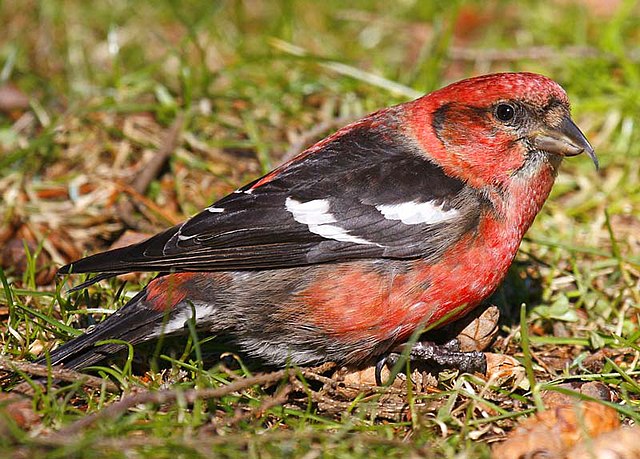
In the state of Illinois, sightings of the White-winged Crossbill are considered rare and sporadic, with occasional reports near Chicago during the winter season.
The White-winged Crossbill is a unique finch species distinguished by its crossed beak. Male individuals showcase vibrant red plumage, complemented by black wings, tails, and two distinct white wingbars. Females, on the other hand, exhibit a combination of yellow and brown feathers, also adorned with the two characteristic white wingbars.
Scientific name: Loxia leucoptera Size: 5.9-6.7 inches (15-17 cm) Weight: 0.8-0.9 ounces (24-26 g) Wingspan: 10.2-11.0 inches (26-28 cm)
White-winged Crossbills primarily inhabit forests in Canada and Alaska, venturing into northern US states on rare occasions when cone crops are scarce. They rely on seeds found in spruce forests for their sustenance.
One fascinating aspect of the White-winged Crossbill is its breeding behavior, as they are known to breed throughout the year as long as an adequate food supply is available.
These birds often congregate in large flocks, and their presence is accompanied by distinctive calls that can be quite noticeable in their woodland habitats. Keep an ear out for their unique vocalizations and an eye out for their striking plumage, as encountering the White-winged Crossbill in Illinois is a special treat indeed.
9. Painted Bunting
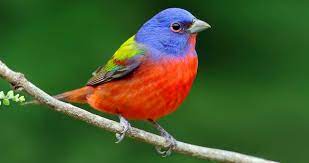
In Illinois, Painted Buntings are considered accidental visitors, with occasional sightings during the winter season. Some reports have come from Chicago, while a few have been noted in Bloomington.
Male Painted Buntings exhibit a remarkable blend of vibrant colors, with a predominantly red plumage underneath, accompanied by bright blue heads, green wings, and backs. Females, on the other hand, showcase a striking bright yellow-green appearance.
Scientific name: Passerina ciris Size: 4.7-5.1 inches (12-13 cm) Weight: 0.5-0.7 ounces (13-19 g)
Painted Buntings breed in specific states within the south-central and southeastern regions of the United States. During their migration, they travel at night, heading to Central America, southern Florida, and selected Caribbean islands.
These birds can be found in semi-open habitats, where they forage primarily for seeds and insects during the breeding season.
To attract Painted Buntings to your yard, consider incorporating low, dense vegetation that provides cover and food sources. Additionally, setting up feeders with offerings such as white millet or black oil sunflower seeds can also increase the likelihood of attracting these stunning birds to your outdoor space.
10. Pine Grosbeak
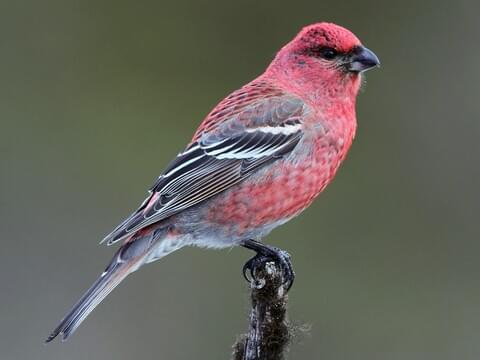
The Pine Grosbeak is an infrequent and uncommon species in Illinois, with only a handful of reported sightings in Springfield, Quincy, and Chicago.
Male Pine Grosbeaks showcase a striking red plumage with gray accents on their wings and tail, adorned with two white wingbars. Females, on the other hand, possess a more subdued gray appearance with dull orange heads and rumps. These finches are relatively large in size compared to other finch species and have a leisurely flight.
Scientific name: Pinicola enucleator Size: 7.9-9.8 inches (20-25 cm) Wingspan: 13.0 inches (33 cm)
Pine Grosbeaks primarily inhabit Canada, but some individuals may occasionally be observed along the US border, particularly in the mountainous regions of the west and the Sierra Nevada in California.
These birds favor forests dominated by pine, spruce, and fir trees, where they feed on seeds, fruits, and buds from these coniferous trees. During the summer months, they may also supplement their diet with insects.
To attract Pine Grosbeaks to your yard, consider offering black oil sunflower seeds through feeders or providing suet feeders. These food sources are particularly appealing to this species and can increase the likelihood of their presence.
11. Hepatic Tanager

Hepatic Tanagers are an exceptionally rare sight in Illinois, with just a single sighting recorded in Pittsfield.
Male Hepatic Tanagers display red plumage with hints of gray on their back, while females have a yellowish appearance.
Scientific name: Piranga flava Size: 3.5-7.9 inches (8.8-20 cm) Weight: 0.8-1.7 ounces (23-47 g) Wingspan: 12.6 inches (32 cm)
Hepatic Tanagers breed in the southwestern states and Mexico before embarking on their winter migration to Mexico, Central, and South America.
These birds can be found in mountainous regions with pine or mixed woodlands consisting of pine and oak trees. They primarily feed on insects and spiders, although they may also consume berries such as cherries and grapes.
To gain a comprehensive understanding of the frequency of red bird sightings in Illinois during the summer and winter seasons, it is advisable to consult state-specific checklists. These checklists provide valuable insights into the common red bird species recorded on eBird checklists for Illinois.
